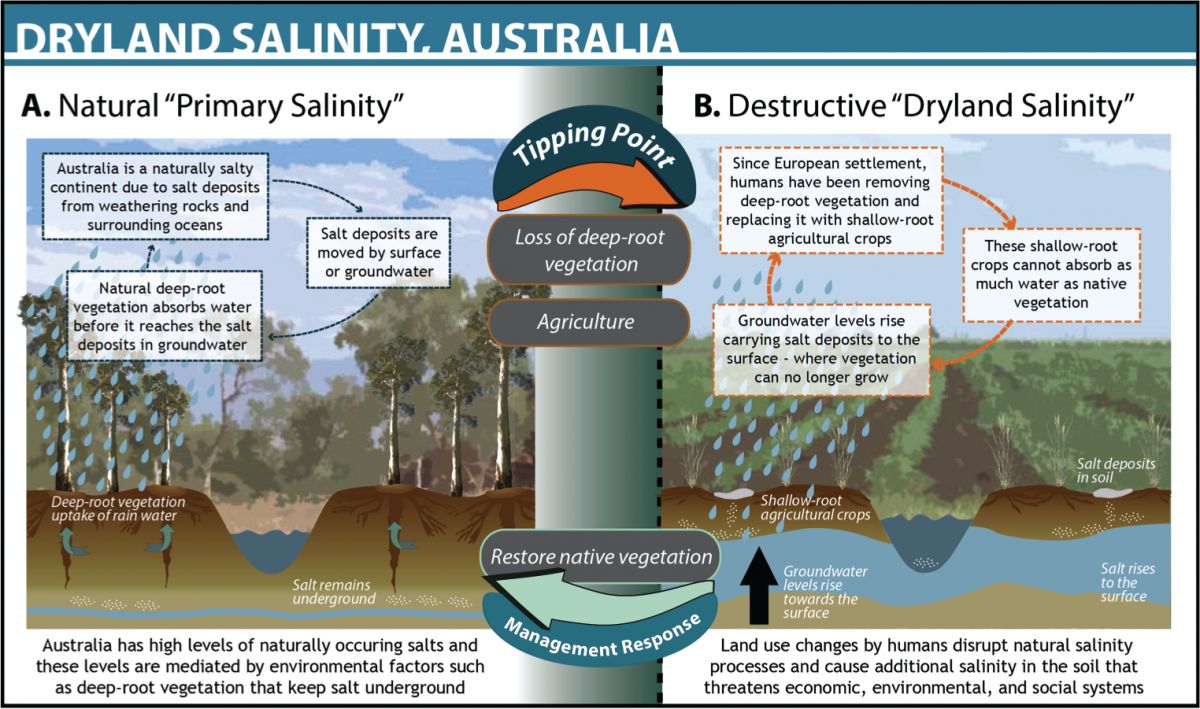Clearing of native trees and replacement with shallow-rooted crops has disrupted Australia's natural water cycle and led to severe soil salinization
Tipping points for dryland salinity
One of the driest continents on the planet, Australia’s subsoils contain some of the world's largest underground salt deposits from centuries of rock erosion and sea salt deposition from surrounding oceans.1 Water can transport these salt deposits either deeper into the earth or up to its surface. Native deep roots plants absorb most water entering Australian soils before it can dilute subsurface salt reserves.1
However, increasing land use changes, such as agriculture and urban development have been disrupting natural salinity and bringing more salt to the surface of the drylands.2 Since European settlement, Australia’s landscapes have been altered by removing massive regions of native vegetation and replacing them with shallow-rooted agricultural crops to feed the country’s growing population.2 These shallow-rooted crops cannot absorb as much water, causing the groundwater levels to rise.2 Salt deposits then rise to the surface with the rising water table and deposit in low-lying regions, reducing agricultural crop growth, contaminating freshwater resources, destroying infrastructure such as concrete roads, and harming native plants and animals in low-lying habitats.2
Salinity has been identified as the greatest environmental threat facing Western Australia, affecting the environment, the economy, and the social systems of Australian communities. Researchers estimate that about a third of cleared land will become saline if current agricultural practices continue3 and up to $400 million per year will be lost in agricultural production by 2050.3
How Managers Tackled the Problem
Although rising stream salinity was first reported before the 1900s, only recently have management plans been created to address Australia’s salinity crisis.4
In 1996, the first Salinity Action Plan was released and included a 30 year vision to address dryland salinity.3 The plan identified regions in Western Australia where drylands were projected to deteriorate beyond recovery unless action was taken.4 Those actions included replanting native vegetation and setting water quality targets to be met within specific time frames.4 Managers found water diversion and groundwater pumping to be effective methods for lowering river salinity.4 In 2000, the government released an updated Salinity Strategy that highlighted the need for aggressive, new land management practices to achieve a moderate level of salinity control.3 The updated plan includes working with key partnerships and stakeholders, analyzing risk in various regions over time, adopting a mix of tools to manage salinity, helping farmers transition to sustainable production, and promoting research and development to improve salinity management.3
What We Can Learn
Salinity in the soils, groundwater, and rivers is a serious threat to ecosystems and human communities in Australia. The consequences of clearing native vegetation over the past few centuries now threatens major regions of Australia’s continent and the productivity and sustainability of its agricultural economy. While a national policy to control, monitor, and potentially reverse the effects of Australia’s dryland salinity exists, management is often in the hands of private land owners, whose perceptions of the severity of dryland salinity often underestimate its real impact.5 Enforcement of land use policies by these diffuse land managers is challenging due to the geographic size of the affected land and the significant time lag between the cause of salinity and the enduring effects.2 The management plan clearly identifies the need to adapt land use practices to local conditions and, more importantly, empower local farmers and communities to be their own stewards. How farmers might be motivated to creatively tackle this enormous management challenge, and avoid more tipping points in dryland salinity across the continent remains to be seen.
As the Ocean Tipping Points team has come to understand, the most successful scenarios for resource management occur when management is threshold-based, populations are monitored routinely, and the geographic scale for management is relatively small.
Learn more about our Management Review research and Ocean Tipping Points project.






